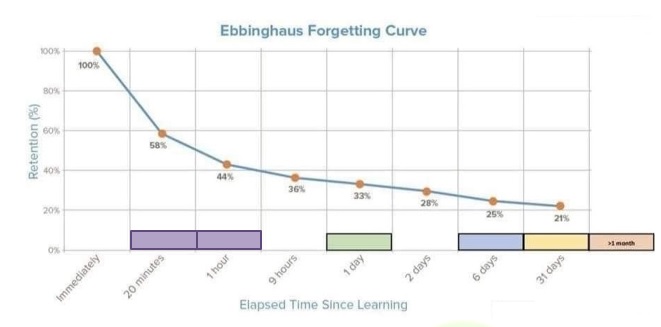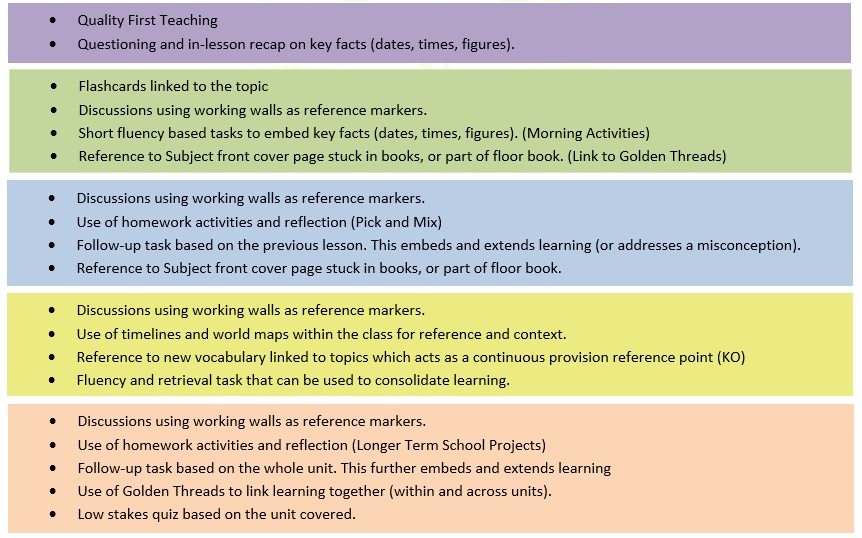Spacing and Retrieval Practice
Spacing and Retrieval
“Learning is defined as an alteration in long-term memory. If nothing has altered in long-term memory, nothing has been learned”
What is Spacing?
Spaced retrieval practice (spaced practice) means studying information more than once but leaving time between practice sessions. In short, it’s the process of spreading learning over time. Evidence suggests that spaced practice is more effective for long-term retrieval.
Spaces in learning cause memory to no longer be fresh in our minds: ‘some forgetting has set in and you’ve got to work harder to recall the concepts’. The additional effort required to retrieve what we have learned helps to make our learning stronger.
What is the Neuroscience behind Spaced Practice?
When we perceive the world, our brains convert the perceptual data from our senses into electrical and chemical signals, through which our minds form mental representations of what we have perceived. The neurological process where perceptual data is converted into mental representations is called encoding. The new mental representations formed through this process are called memory traces. Consolidation is the process of strengthening mental representations in our long-term memory.
This process unfolds over hours and may take several days, for several reasons. First, this time period is required for memory consolidation to take place. Second, for learning to be durable, we need time in which we can mentally rehearse what we have learned, to remember it better and apply it in other contexts. Third, by incorporating time gaps, we have to make increased effort to retrieve our learning, which can make our learning stronger.
How Long Should the Spaces be?
- For learning simple things such as sets of names and faces, you have to review them regularly, because these associations are forgotten quickly. This can be done within the lesson through targeted questioning or at the start of the following lesson through starter activities, flash cards and questioning.
- To re-learn new material linked to a topic, this will need to be revisited within a day or so of your first encounter with it’; after that, ‘perhaps not again for several days or a week’.
- After the regular revisits have been completed and when children are more confident with certain material, quizzes and higher level activities can be completed towards the end of a unit of work (1 month-6 weeks).
 The forgetting curve is a memory model created by German psychologist Hermann Ebbinghaus. The memory curve shows how we lose information over time if we don’t try to retain it. As such, it helps us to tackle the common challenges of forgetting information without adequate retention/retrieval.
The forgetting curve is a memory model created by German psychologist Hermann Ebbinghaus. The memory curve shows how we lose information over time if we don’t try to retain it. As such, it helps us to tackle the common challenges of forgetting information without adequate retention/retrieval.
At Newton St. Cyres, we have used Ebbinghaus’ Forgetting Curve alongside our knowledge on ‘spaced retrieval’ to build activities for the children to ensure that their long-term memory is altered positively and that key concepts and ideas are embedded more thoroughly.
Based on the spacing principles above, we have generated a resource bank of colour coded retrieval activities which support children’s learning. These are used throughout a unit of work, as well as other intervals throughout the year. The type of activity chosen is at the discretion of the teacher, based on the subject/topic being covered, the time period it is being used and the suitability of the task. Retrieval activities linked to Ebbinghaus’ Forgetting Curve can be found below:


